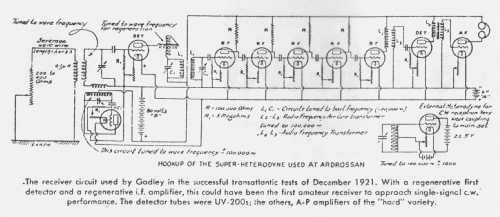Transatlantic Super-Heterodyne
Homebrew - ORIGINAL, USA
- Country
- United States of America (USA)
- Manufacturer / Brand
- Homebrew - ORIGINAL, USA
- Year
- 1921
- Category
- Broadcast Receiver - or past WW2 Tuner
- Radiomuseum.org ID
- 342499
Click on the schematic thumbnail to request the schematic as a free document.
- Number of Tubes
- 10
- Valves / Tubes
- UV200 A_Moorhead A_Moorhead A_Moorhead A_Moorhead A_Moorhead A_Moorhead UV200 A_Moorhead A_Moorhead
- Main principle
- Superheterodyne (common)
- Wave bands
- Broadcast and LongWave in ONE range.
- Power type and voltage
- Storage and/or dry batteries / 6 & 80 & 22,5 Volt
- Loudspeaker
- - This model requires external speaker(s).
- Material
- Wooden case
- from Radiomuseum.org
- Model: Transatlantic Super-Heterodyne - Homebrew - ORIGINAL, USA
- Shape
- Tablemodel, Box - most often with Lid (NOT slant panel).
- Notes
-
A Super-Heterodyne used at Ardrossan.
The receiver circuit used by Godley in the succesful transatlantic test of December 1921. With a regenerative first detector and a regenerative i.f. amplifier, this could been the first amateur receiver to approach single-signal c.w. performance.The detector tubes were UV-200s, the others, A-P amplifiers of the "hard" variety.
This is the original legend of the schematic.
From an article by Sergio Pandolfi on "Radio Rivista" official organ of "ARI Amateur. Radio Association." of Italy, April 1976.
This receiver was built for the transatlantic tests done in November 1921. The receiver was used to listen to the time signals.
- Mentioned in
- “Radio Rivista” official organ of "ARI Amat. Radio Assoc." of Italy, number 1, January 1978.
- Author
- Model page created by Pier Antonio Aluffi. See "Data change" for further contributors.
- Other Models
-
Here you find 36 models, 20 with images and 5 with schematics for wireless sets etc. In French: TSF for Télégraphie sans fil.
All listed radios etc. from Homebrew - ORIGINAL, USA
